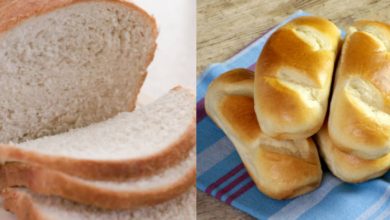Are You Eating Expired White Bread? Find Out The Truth About Shelf Life And The Dangers Of Eating Stale Bread!
What To Know
- Staling is a process that occurs when the starch molecules in bread recrystallize, resulting in a dry, crumbly texture.
- Wrap the bread in a damp paper towel and microwave on high for 10-15 seconds at a time, checking for desired softness.
- Remember, the journey of bread preservation is an art form, and with a little care and attention, we can savor the goodness of white bread without compromising its quality or safety.
Does white bread expire? It’s a question that has puzzled many bread enthusiasts. While we all know that bread doesn‘t last forever, understanding the factors that affect its shelf life is crucial for ensuring freshness and preventing waste. In this comprehensive guide, we will delve into the world of white bread expiration, exploring the science behind spoilage, storage techniques, and everything you need to know to keep your bread as fresh as possible.
How Does White Bread Go Bad?
White bread, like all bread, spoils primarily due to two factors: microbial growth and staling.
Microbial Growth: Bacteria, mold, and yeast are the main culprits responsible for bread spoilage. These microorganisms thrive in the moist environment of bread, consuming its nutrients and producing waste products that cause unpleasant odors, discoloration, and eventually, rot.
Staling: Staling is a process that occurs when the starch molecules in bread recrystallize, resulting in a dry, crumbly texture. While staling does not pose a health risk, it significantly affects the bread’s palatability.
Factors Affecting White Bread’s Shelf Life
Several factors influence the shelf life of white bread, including:
- Packaging: Unwrapped bread is more susceptible to moisture loss and microbial contamination, reducing its shelf life.
- Storage Temperature: Bread should be stored at room temperature (70-75°F) to prevent rapid staling and microbial growth.
- Refrigeration: Refrigerating bread can extend its shelf life by slowing down microbial growth and staling, but it can also dry out the bread more quickly.
- Additives: Preservatives added to commercial white bread can inhibit microbial growth and extend shelf life.
- Humidity: High humidity promotes microbial growth, while low humidity accelerates staling.
How Long Does White Bread Last?
The shelf life of white bread varies depending on the factors mentioned above. As a general rule of thumb:
- Unwrapped at Room Temperature: 2-3 days
- Wrapped at Room Temperature: 3-5 days
- Refrigerated: 5-7 days
- Frozen: Up to 3 months
Signs of Spoiled White Bread
It’s essential to be able to identify signs of spoiled white bread to avoid consuming contaminated food. Look for:
- Mold: Visible mold growth is a clear indication of spoilage.
- Off-Odors: A sour, musty, or rancid smell indicates microbial contamination.
- Discoloration: Changes in color, such as green, blue, or black spots, suggest mold growth.
- Slimy Texture: A slimy or sticky surface indicates bacterial contamination.
How to Store White Bread Properly
Proper storage techniques can significantly extend the shelf life of white bread:
- Store in a Cool, Dry Place: Keep bread at room temperature in a breadbox or airtight container to prevent moisture loss and microbial growth.
- Avoid Refrigeration: Refrigerating bread can dry it out more quickly. However, if you plan to keep bread for more than a few days, refrigeration is recommended.
- Freeze for Long-Term Storage: Freezing bread is an excellent way to extend its shelf life for up to 3 months. Wrap the bread tightly in plastic wrap before freezing.
Reheating and Refreshing Stale Bread
Stale bread can be revived with a few simple techniques:
- Reheat in the Oven: Preheat the oven to 350°F and wrap the bread in aluminum foil. Heat for 5-10 minutes, or until warmed through.
- Microwave: Wrap the bread in a damp paper towel and microwave on high for 10-15 seconds at a time, checking for desired softness.
- Sprinkle with Water: Lightly sprinkle water on the bread and wrap it in a damp paper towel. Microwave on high for 10-15 seconds, or until warmed through.
Takeaways: Embracing the Art of Bread Preservation
Understanding the factors that affect white bread‘s expiration date empowers us to make informed decisions about storage and consumption. By following proper storage techniques, we can prolong the freshness of our bread, reduce waste, and enjoy the delightful taste of fresh-baked bread for longer. Remember, the journey of bread preservation is an art form, and with a little care and attention, we can savor the goodness of white bread without compromising its quality or safety.
Questions You May Have
Q1: How do I know if white bread is safe to eat?
A1: If the bread has no visible mold, off-odors, discoloration, or a slimy texture, it is likely safe to eat.
Q2: Can I eat white bread after the expiration date on the packaging?
A2: It is not recommended to consume white bread after the expiration date as it may have spoiled and become unsafe to eat.
Q3: How long can I store homemade white bread?
A3: Homemade white bread typically has a shorter shelf life than commercial bread due to the lack of preservatives. Store it at room temperature for 1-2 days or refrigerate for 3-5 days.
Q4: Can I freeze homemade white bread?
A4: Yes, you can freeze homemade white bread for up to 2 months. Wrap it tightly in plastic wrap before freezing.
Q5: How do I prevent white bread from molding?
A5: Store bread in a cool, dry place and avoid exposure to moisture. Keep it in a breadbox or airtight container.
